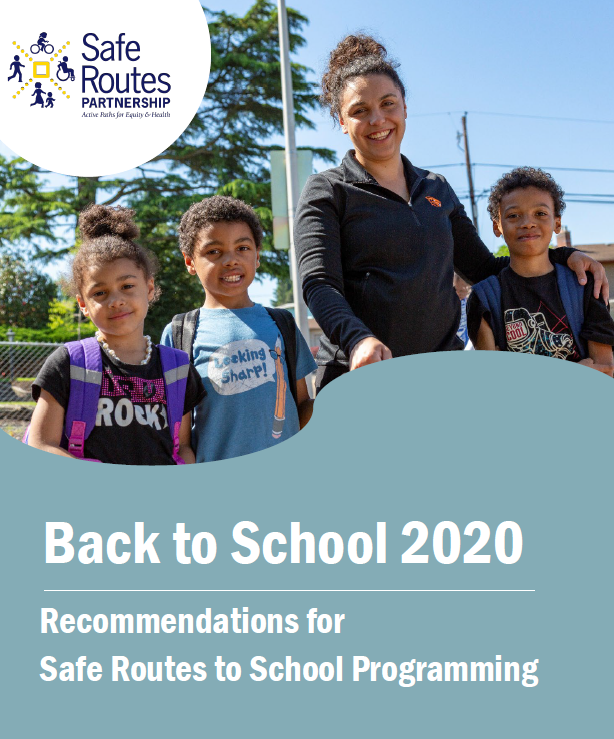Written by Kori Johnson, Program Support Manager, and Becky Gilliam, Pacific Northwest Regional Policy Manager
In a few short weeks, kids across the country will begin heading back to school. Some will enter their classrooms and smile at their teachers from behind masks. Others will hop on bikes and feel the breeze rush across their cheeks instead of sticky school bus air. A high school senior will help his younger sister log on to her online class before opening his laptop to do the same. Another will sit at a desk six feet apart from her best friend, but only for three days a week. On remote-learning days, her grandmother will become her desk partner as they work together from the kitchen table. This is the portrait of Back to School 2020. It will be new. It will not be what we knew just a year ago or considered normal - and that’s okay.
At Safe Routes Partnership, we recognize that “normal” is a mindset defined by those with the most power, privilege, and access. It does not reflect the rich diversity of our lived experiences, our struggles, and our dreams for the future. When we started thinking about our role in back to school planning, we were conscious of the urge to return to normal. We decided that the appropriate counter-action was finding a way to move forward, even if it meant confronting the unknown. We also recognized that communities are at the heart of what we do, and our journey forward would be better if we made it together.
This summer, we paused our usual work to form a Back to School 2020 Working Group of Safe Routes to School practitioners and champions from across the country, spanning small mountain towns to our biggest coastal cities. Their task was to develop a set of recommendations for implementing Safe Routes to School programs in the context of three different back to school scenarios: remote programming, in-person programming, and hybrid programming. For four weeks, they gathered on Zoom to share ideas, resources, strategies, and guidance that will help kids and families walk and roll this fall whether they head to their school building or learn at home. Led predominantly by women and people of color, the group reflected and responded directly to the needs of communities most impacted by COVID-19. As we publish their recommendations in Back to School 2020: Recommendations for Safe Routes to School Programming, we take a moment to appreciate their time, expertise, enthusiasm, and commitment to advancing safe walking and rolling for everyone.
Using the six E’s framework - Engagement, Equity, Engineering, Encouragement, Education, Evaluation - the Back to School 2020 guide offers strategies, tools, considerations, and advice for running Safe Routes to School programs this fall and beyond. The recommendations are short-term, actionable, and designed for you to pick and choose what works best for your community. They include a variety of ways for you to help kids and families stay safe and active during COVID-19, along with a few longer-term considerations as your program evolves. The guide also offers trauma-informed engagement approaches to Safe Routes to School and opportunities to collaborate with community partners to deliver essential needs and services.
Even with this guidance, we know there are challenges ahead. There are concerns about funding, staff and volunteer capacity, community resistance to mask-wearing and physical distancing, and the reality that some families cannot prioritize walking and biking when they are wondering how they will put dinner on the table. We encourage you to acknowledge these challenges, then we invite you to consider what is possible in this moment. As you read through the list of recommendations ask yourself, “What am I capable of doing right now? What can wait until later? What am I excited to try out? What inspires me?” Then, go for it! Start small if you want, or pair up with a buddy to test out a new idea. There is no need to do everything now, just pick what makes sense for you - or even something that just sounds like fun.
Some of you might organize a remote Walk to School Day celebration this October. Others might send out at-home walking and rolling activity calendars in your email newsletters. One of you might take a walk in a neighborhood you have never been to before to better understand the safety challenges students in that community face. Another one of you might reach out to your local food pantry to see if there are ways you can work together to ensure the health and safety of all families. However you support your communities this fall, know that you can play an important role even if it looks a little different than before. This is our chance to connect with each other, grow our movement of people walking and biking, and dismiss the return to “normal” in order to shape our own, better future.
We welcome you to learn with us, experiment with us, share with us, and move forward with us.
- Stay tuned for opportunities to engage this fall through virtual gatherings and webinars
- Sign up for our monthly e-news, stay connected to our blog, and follow us on Twitter and Facebook for regular updates
- Let us know how you are using the Back to School 2020 recommendations and connect with other Safe Routes leaders with the hashtag #SRTS2020 on social media
- Share your back-to-school experience on the Safe Routes to School list-serve
- Drop us an email at info@saferoutespartnership.org.

